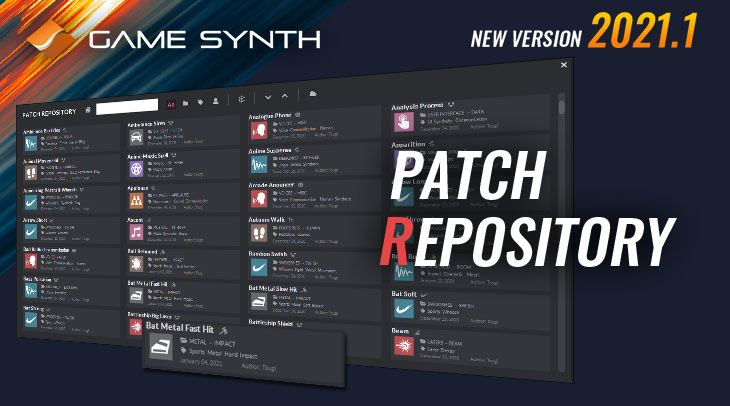The Patch Repositoy of GameSynth is the largest collection of procedural audio models for games and animations. It is a great way to quickly find a patch suited to your project, or to get some inspiration. It is also an incredibly useful tool to learn general procedural techniques and sound design in GameSynth.
The repository is curated by Tsugi to guarantee the high quality of the patches included, which cover all GameSynth models and all types of sound effects. New patches are regularly added and when you start GameSynth, the tool will notify you if there is anything new.
A database for procedural models
The repository essentially works like a sound effects database. Instead of listing fixed sample files though, it displays dynamic procedural audio models, or patches. Like most recent sound databases, it also supports the Universal Category System (UCS) to organize its files. Thus, for the first time, sound designers can browse procedural patches like they would browse wave files and search them using the exact same terms. The patches can be previewed immediately and loaded with single a click.
All the properties that are displayed for a patch (model, category, subcategory, tags, author, date) have hyperlinks allowing you to find similar patches in one click. Each one of the 82 UCS categories also has its own icon, making it easy to identify the type of a patch.

A powerful back end
The back end of the Patch Repository is built to manage hundreds of thousands of files if necessary. In addition to the hyperlink navigation, this allows for immediate searching, sorting, and filtering operations across the patch database.
![]()
You can enter a text and search patches per name, category, tag, author, or any combination of these. You can also sort the results of the search based on these same parameters, in ascending or descending order. Finally, it is possible to filter patches based on the GameSynth model used, such as Particles, Modular, Impact etc.
Handy shortcuts allow you to do all that from the keyboard as well, so don’t forget to check the documentation!













